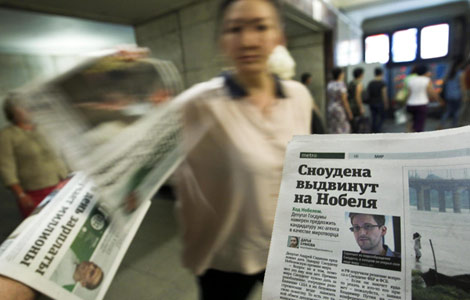Data show shifts in US, China economies
Updated: 2013-07-04 12:00
By Joseph Boris in Washington (China Daily)
|
||||||||
Official data on US exports and imports in May show further widening of America's trade deficit with China, but they also signal shifting directions of the world's two biggest economies, with implications for global growth.
According to the Commerce Department, the US in May imported $45 billion more in goods and services than it sent abroad. Weak global demand, including from slower-growth China, pushed US exports down. But the bigger-than-expected monthly jump in the trade deficit was also fueled by higher imports, mostly from China.
Several surveys of economists had predicted a May trade-gap total more or less flat with April's upwardly revised $40.1 billion. Instead, the $45 billion figure represents the biggest one-month increase since November, and the $232 billion value of imports was the second-highest in US history, just $2 billion off the mark set in March 2012.
US exports' total value in May was $187.1 billion, the Commerce Department said in a report that also revealed a stark difference in month-to-month trends: exports down by a seasonally adjusted 0.3 percent, and imports up 1.9 percent.
The US trade imbalance with China expanded to $27.9 billion, from $24.1 billion in April.
The more recent month saw a $200 million decrease, to $8.8 billion, in exports to China (mainly civilian aircraft, engines, equipment and parts) and an increase in imports of $3.5 billion, or 10.7 percent, to $36.6 billion (mainly mobile phones and other household items). These figures weren't adjusted for seasonal fluctuations in trade activity.
Strong demand for exports has kept the US growing, albeit around a modest 2 percent, in recent years. Without it, many economists fear the economy could fail to break out of this extended post-crisis pattern, or even fall into a 1.5 percent range or worse. Last week, the Commerce Department revised its estimate of first-quarter GDP growth, to an annualized rate of 1.8 percent from an initial projection of 2.4 percent, largely due to reduced consumer spending.
Meanwhile, investors and major US government creditors such as China are trying to guess when and if the Federal Reserve will decide to begin tapering its program of bond-buying, or "quantitative easing", presumably based on a determination that the recovery could sustain itself without the central bank's stimulus, which is now on a pace of about $45 billion a month.
After Wednesday's early closing on US markets before the Independence Day holiday, eyes will be on the Labor Department's monthly jobs report on Friday, since unemployment (now 7.6 percent) is a key driver of the Fed's monetary policy.
"It's not going to be a great recovery," economist Adam Posen said of his outlook for the US this year and next.
Posen, president of the Peterson Institute for International Economics in Washington and a former member of the Bank of England's monetary-policy committee, expects US GDP to grow by 2.5 percent or slightly better in 2013 and 3.0 percent in 2014.
"The sequester, as I expected, took less off the [US] economy than some people feared," Posen, referring to the US government's self-inflicted remedy of spending cuts, said at a seminar a day before Wednesday's trade data report. Despite recent increases in some medium-term US bonds, he believes the increasingly strong housing market will help sustain the American economy for the next 18 months at least.
"There's enough of a lag between when the interest rates move and [when] you feel it in the real economy, that actually 2013 will be OK. I could be wrong, I could be underestimating how fast and how big the interest-rate hit is, but I am reasonably confident it's going to be OK." He feels the same about 2014, saying that higher interest rates - driven by a potential Fed move away from quantitative easing - and a rise in the dollar's value would likely be offset by continued slower growth in China, which will reduce demand and prices for global commodities.
By the end of Wednesday's preholiday trading session, the benchmark 10-year US Treasury note had fallen 9/32 in price, pushing its yield up to 2.505 percent. Bond prices decrease when their yields increase. Trading volume in Treasurys was about 30 percent less than the average over the past two weeks.
Nicholas Lardy, an expert on the Chinese economy and Posen's colleague at the Peterson Institute, said the latest US-China trade data are likely to "heighten the desire on the US side to pin China down as much as possible on the domestic reform agenda and how it will promote rebalancing" when officials from each country meet next week in Washington. The fifth Strategic and Economic Dialogue runs from Monday through Friday and is sure to include a repeat of American pressure for China to further liberalize its economy.
In China, Premier Li Keqiang said last week that the country is on track to meet its 7.5 percent GDP growth target for this year even as the economy moves toward a consumption-driven model and away from export-led growth. The Chinese economy has expanded by less than 8 percent for four consecutive quarters, its lowest rate in 20 year. The National Bureau of Statistics is scheduled to report second-quarter GDP numbers on July 15.
Both of China's manufacturing purchasing managers indexes were lower in June than in May, the government said this week, indicating flagging growth in the second quarter. Both indexes may have been pulled down by credit tightening among Chinese banks, particularly tied to nontraditional "shadow banking", that began last month and prompted the People's Bank of China to allow a sharp increase in short-term borrowing rates. That was seen as a warning to loose-credit banks to rein in risky loans.
The Peterson Institute's Posen and Lardy both praised the PBOC for its blunt move as well as the level of communication it has with the Fed. This helps the two central banks understand and respond to each other's monetary policies, which aids global economic stability, the scholars said.
josephboris@chinadailyusa.com
(China Daily USA 07/04/2013 page1)

 Ecuador finds spy mic for Assange meeting
Ecuador finds spy mic for Assange meeting
 US martial artists arrive at Shaolin Temple
US martial artists arrive at Shaolin Temple
 July 4 in Prescott: Balance of grief, patriotism
July 4 in Prescott: Balance of grief, patriotism
 Jubilant crowds celebrate after Mursi overthrown
Jubilant crowds celebrate after Mursi overthrown
 Growth slowing for services
Growth slowing for services
 Venezuela eyed as Snowden seeks asylum
Venezuela eyed as Snowden seeks asylum
 Anti-terror drill staged in Xinjiang
Anti-terror drill staged in Xinjiang
 Memorial service held for 19 Arizona firefighters
Memorial service held for 19 Arizona firefighters
Most Viewed
Editor's Picks

|

|

|

|

|

|
Today's Top News
US welcomes China's engagement in Africa
Data show shifts in US, China economies
Obama, Merkel agree talks on surveillance program
Filipino executed for drug trafficking
Obama orders US to review aid to Egypt
Snowden still in Moscow
China urges more efficient uses of fiscal funds
Egypt army topples president Morsi
US Weekly

|

|






